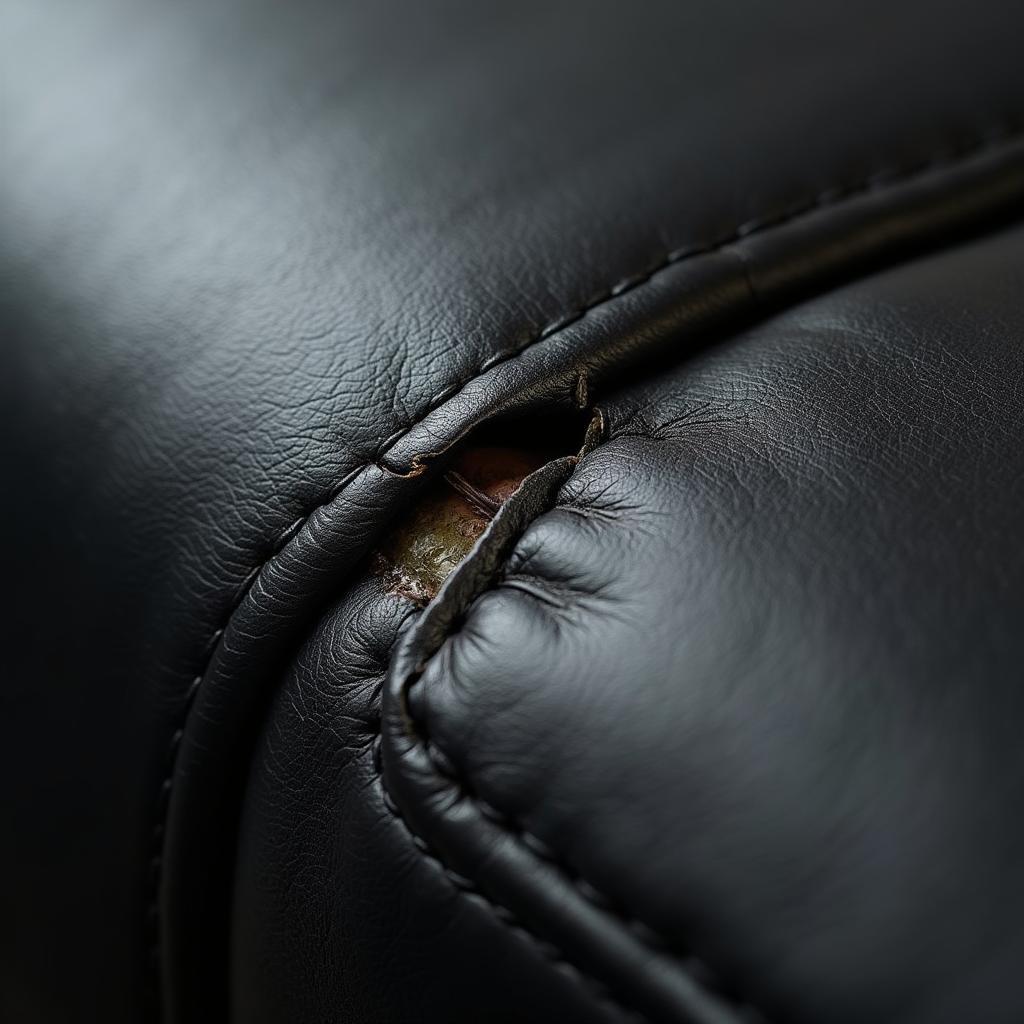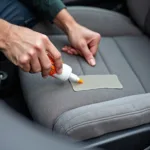Leather car seats add a touch of luxury and comfort to any vehicle. However, over time, they can be prone to wear and tear, especially tears. But before you rush off to an expensive car upholstery shop, know that you can often repair minor to moderate leather car seat tears yourself with the right tools and techniques. This guide will provide you with a comprehensive step-by-step approach to effectively address those unsightly tears and restore your car’s interior.
Assessing the Damage: What Kind of Tear Are You Dealing With?
Before diving into the repair process, it’s crucial to assess the severity of the tear.
- Minor Tears and Cracks: These are small, superficial tears that haven’t penetrated the leather’s backing.
- Moderate Tears: These tears are larger and may have slightly frayed edges, but the tear doesn’t extend to the seams or stitching.
- Severe Tears and Rips: These require professional intervention. If the tear is extensive, involves the seams, or reveals the seat’s padding, it’s best to consult a professional upholstery shop.
Gathering Your Tools and Materials
Having the right tools and materials is essential for a successful leather car seat tear repair. Here’s a checklist:
- Leather Repair Kit: These kits are widely available online or at auto parts stores and typically contain everything you need: leather filler, a color matching kit, adhesive, a palette knife, and various grain paper textures.
- Clean Microfiber Cloths: For cleaning and drying the affected area.
- Rubbing Alcohol: Used to degrease the leather surface before the repair.
- Scissors: To trim any loose threads or frayed edges.
- Hair Dryer: To speed up the drying process of the leather filler.
How to Repair Tears in Leather Car Seats: A Step-by-Step Guide
Now that you have your tools and materials ready, let’s proceed with the repair:
- Clean the Area: Begin by cleaning the torn area with a microfiber cloth and rubbing alcohol to remove any dirt, grime, or residue. This ensures proper adhesion of the repair materials.
- Trim Loose Edges: Using scissors, carefully trim any loose threads or frayed edges around the tear. Avoid cutting into the intact leather.
- Apply Leather Filler: If the tear is more than a small crack, apply a thin layer of leather filler to the torn area using the palette knife. Ensure the filler fills the gap completely. Use a hair dryer to accelerate the drying process if needed.
- Sand and Repeat (If Necessary): Once the filler dries, sand the area lightly with fine-grit sandpaper until smooth. If needed, apply additional layers of filler, repeating the drying and sanding process for each layer until the tear is flush with the surrounding leather.
- Apply Colorant: Using the colorant provided in your leather repair kit, carefully match the color of your car’s leather. Apply thin coats of colorant to the repaired area, allowing each coat to dry before applying the next.
- Apply Grain Paper: To replicate the texture of your car’s leather, place the appropriate grain paper over the repaired area while the colorant is still slightly tacky. Press firmly and then peel off to imprint the grain.
- Apply Leather Sealer (Optional): Once the repair is fully dry, consider applying a leather sealer to protect the repaired area and enhance its longevity.
Can You Repair Tears in Leather Car Seats Yourself?
While you can successfully repair minor to moderate tears in your leather car seats yourself, certain situations warrant professional help:
- Large Tears: If the tear is extensive and involves multiple layers of the seat, it’s best left to professionals.
- Seam Damage: Tears along the seams or stitching require specialized sewing techniques that are challenging for DIY repairs.
- Airbag Deployment: If the tear occurred during airbag deployment, it’s crucial to have a professional assess any potential damage to the seat’s structural integrity.
How to Prevent Leather Car Seat Tears
Prevention is always better than cure. Here are a few tips to protect your leather car seats and prevent future tears:
- Regular Cleaning: Regularly clean your leather seats with a leather cleaner and conditioner to prevent drying and cracking.
- Avoid Sharp Objects: Be mindful of sharp objects like keys, pens, or tools that can scratch or puncture the leather.
- Pet Protection: Use a pet seat cover to protect your seats from scratches and tears caused by pet claws.
- Sunlight Protection: Prolonged exposure to direct sunlight can fade and dry out leather. Use a sunshade or park in shaded areas whenever possible.
Conclusion
Repairing minor to moderate leather car seat tears can save you money and maintain the aesthetic appeal of your car’s interior. By following the DIY steps outlined in this guide, you can effectively address these blemishes and restore your leather seats to their former glory. However, always remember to assess the damage honestly and seek professional help when needed. Regular care and preventive measures will go a long way in prolonging the life and beauty of your leather car seats.
FAQs
1. What is the best leather repair kit for car seats?
Several reputable brands offer leather repair kits specifically designed for car seats. Look for kits with positive reviews, a wide range of color options, and comprehensive instructions.
2. How long does a leather seat repair last?
With proper care and maintenance, a DIY leather seat repair can last for several years.
3. Can I use super glue to fix a tear in my leather car seat?
While it might seem tempting, avoid using super glue or other harsh adhesives on leather car seats. These adhesives can damage the leather further and create an uneven and unsightly finish.
4. Can I dye my leather car seats a different color?
Dyeing leather car seats is a complex process best left to professional upholstery shops.
5. How often should I condition my leather car seats?
It’s generally recommended to condition your leather car seats every three months or as needed, depending on factors like climate and usage.
For more in-depth information on specific types of car leather seat repairs, check out these helpful resources:
Have more questions or need assistance with your car repairs?
Feel free to reach out to our expert team via WhatsApp at +1(641)206-8880 or email us at [email protected]. We’re available 24/7 to provide you with the best possible support and guidance.



